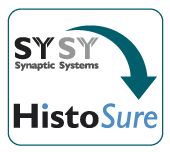|
|
|
|
| Cat. No. HS-531 008 |
50 µg purified recombinant IgG, lyophilized. Albumin and azide were added for stabilization. For reconstitution add 50 µl H2O to get a 1mg/ml solution in PBS. Then aliquot and store at -20°C to -80°C until use. Antibodies should be stored at +4°C when still lyophilized. Do not freeze! |
| Applications |
IP: not tested yet ICC: not tested yet IHC-P: 1 : 400 up to 1 : 1000 gallery ELISA: not tested yet |
| Clone | Rb-HNK-1 |
| Subtype | IgG1 (κ light chain) |
| Immunogen | Membrane extract of human lymphoblastoid cell line HSB-2 (UniProt Id: Q9P2W7) |
| Reactivity |
Reacts with: human (Q9P2W7). No signal: mouse, rat. Other species not tested yet. |
| Remarks |
This antibody is a chimeric antibody based on the monoclonal mouse antibody clone HNK-1. The constant regions of the heavy and light chains have been replaced with rabbit specific sequences. The antibody can therefore be used with standard anti-rabbit secondary reagents. The antibody has been expressed in mammalian cells. |
| Data sheet | hs-531_008.pdf |
 Important information
Important information|
|
The human natural killer-1 (HNK-1) glyco-epitope, also known as LEU-7 or CD57, was first identified by a monoclonal antibody that recognizes a subset of human natural killer (NK) cells (1). This epitope features a unique trisaccharide structure, consisting of a 3-O-sulfated glucuronic acid linked to N-acetyl-lactosamine (HSO3-3GlcAß1-3Galß1-4GlcNAc-) and is primarily expressed on glycolipids and glycoproteins within the nervous system. Notable carriers are NCAM, L1, MAG, tenascin-R and tenascin-C (2). Studies in mice lacking HNK-1 expression reveal abnormal brain function, including impaired synaptic plasticity, deficits in dendritic spine maturation and disrupted spatial learning (2-4). In humans, HNK-1 is implicated in various central nervous system (CNS) disorders. For instance, autoantibodies targeting HNK-1 have been detected in certain neuropathies (5). Beyond its role in neural development, HNK-1 also appears to function as tumor suppressor. Elevated HNK-1 expression has been associated with improved survival outcomes in patients with prostate cancer or astrocytic tumors (6,7). In the field of immunology, HNK-1 is most commonly referred to as CD57. It is expressed on a subset of immune cells, particularly T cells and natural killer (NK) cells, and is associated with terminal differentiation and cellular senescence (8).